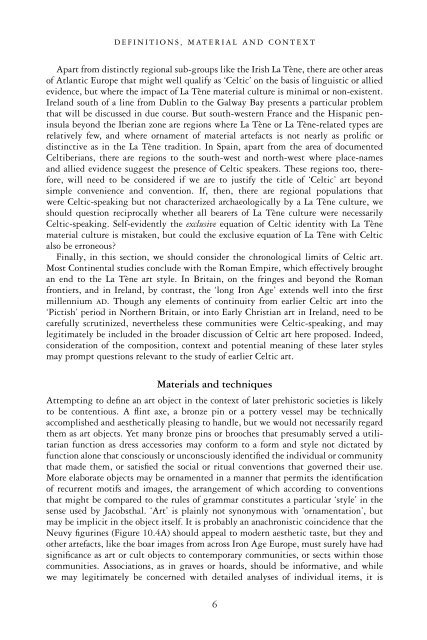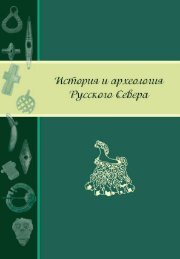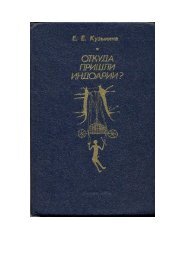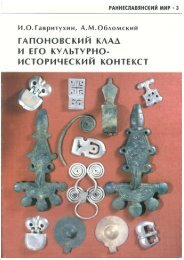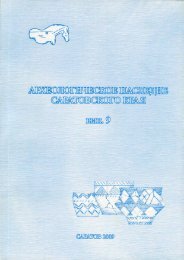The Archaeology of Celtic Art
The Archaeology of Celtic Art
The Archaeology of Celtic Art
- No tags were found...
You also want an ePaper? Increase the reach of your titles
YUMPU automatically turns print PDFs into web optimized ePapers that Google loves.
DEFINITIONS, MATERIAL AND CONTEXTApart from distinctly regional sub-groups like the Irish La Tène, there are other areas<strong>of</strong> Atlantic Europe that might well qualify as ‘<strong>Celtic</strong>’ on the basis <strong>of</strong> linguistic or alliedevidence, but where the impact <strong>of</strong> La Tène material culture is minimal or non-existent.Ireland south <strong>of</strong> a line from Dublin to the Galway Bay presents a particular problemthat will be discussed in due course. But south-western France and the Hispanic peninsulabeyond the Iberian zone are regions where La Tène or La Tène-related types arerelatively few, and where ornament <strong>of</strong> material artefacts is not nearly as prolific ordistinctive as in the La Tène tradition. In Spain, apart from the area <strong>of</strong> documentedCeltiberians, there are regions to the south-west and north-west where place-namesand allied evidence suggest the presence <strong>of</strong> <strong>Celtic</strong> speakers. <strong>The</strong>se regions too, therefore,will need to be considered if we are to justify the title <strong>of</strong> ‘<strong>Celtic</strong>’ art beyondsimple convenience and convention. If, then, there are regional populations thatwere <strong>Celtic</strong>-speaking but not characterized archaeologically by a La Tène culture, weshould question reciprocally whether all bearers <strong>of</strong> La Tène culture were necessarily<strong>Celtic</strong>-speaking. Self-evidently the exclusive equation <strong>of</strong> <strong>Celtic</strong> identity with La Tènematerial culture is mistaken, but could the exclusive equation <strong>of</strong> La Tène with <strong>Celtic</strong>also be erroneous?Finally, in this section, we should consider the chronological limits <strong>of</strong> <strong>Celtic</strong> art.Most Continental studies conclude with the Roman Empire, which effectively broughtan end to the La Tène art style. In Britain, on the fringes and beyond the Romanfrontiers, and in Ireland, by contrast, the ‘long Iron Age’ extends well into the firstmillennium ad. Though any elements <strong>of</strong> continuity from earlier <strong>Celtic</strong> art into the‘Pictish’ period in Northern Britain, or into Early Christian art in Ireland, need to becarefully scrutinized, nevertheless these communities were <strong>Celtic</strong>-speaking, and maylegitimately be included in the broader discussion <strong>of</strong> <strong>Celtic</strong> art here proposed. Indeed,consideration <strong>of</strong> the composition, context and potential meaning <strong>of</strong> these later stylesmay prompt questions relevant to the study <strong>of</strong> earlier <strong>Celtic</strong> art.Materials and techniquesAttempting to define an art object in the context <strong>of</strong> later prehistoric societies is likelyto be contentious. A flint axe, a bronze pin or a pottery vessel may be technicallyaccomplished and aesthetically pleasing to handle, but we would not necessarily regardthem as art objects. Yet many bronze pins or brooches that presumably served a utilitarianfunction as dress accessories may conform to a form and style not dictated byfunction alone that consciously or unconsciously identified the individual or communitythat made them, or satisfied the social or ritual conventions that governed their use.More elaborate objects may be ornamented in a manner that permits the identification<strong>of</strong> recurrent motifs and images, the arrangement <strong>of</strong> which according to conventionsthat might be compared to the rules <strong>of</strong> grammar constitutes a particular ‘style’ in thesense used by Jacobsthal. ‘<strong>Art</strong>’ is plainly not synonymous with ‘ornamentation’, butmay be implicit in the object itself. It is probably an anachronistic coincidence that theNeuvy figurines (Figure 10.4A) should appeal to modern aesthetic taste, but they andother artefacts, like the boar images from across Iron Age Europe, must surely have hadsignificance as art or cult objects to contemporary communities, or sects within thosecommunities. Associations, as in graves or hoards, should be informative, and whilewe may legitimately be concerned with detailed analyses <strong>of</strong> individual items, it is6


